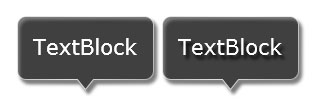
Intersoft ClientUI Documentation
CallOutEffect Property (CallOut)

| Intersoft.Client.UI.Controls Namespace > CallOut Class : CallOutEffect Property |
<CategoryAttribute("Appearance")> Public Property CallOutEffect As Effect
Dim instance As CallOut Dim value As Effect instance.CallOutEffect = value value = instance.CallOutEffect
[CategoryAttribute("Appearance")] public Effect CallOutEffect {get; set;}
[CategoryAttribute("Appearance")] public: property Effect^ CallOutEffect { Effect^ get(); void set ( Effect^ value); }
When you browse through CallOut properties, you would notice two similar Effect properties. The first is CallOutEffect and the other is Effect.
The difference between the two properties is the element of which the Bitmap Effect is applied. The CallOutEffect only applies the effect to CallOut shape, while Effect applies the effect to entire control’s element.
The following example shows the difference between using CallOutEffect and Effect.
| XAML |
Copy Code
|
|---|---|
<StackPanel Orientation="Horizontal"> <Intersoft:CallOut Foreground="White" Margin="4" HorizontalAlignment="Center" VerticalAlignment="Center"> <Intersoft:CallOut.CallOutEffect> <DropShadowEffect/> </Intersoft:CallOut.CallOutEffect> <TextBlock Text="TextBlock" FontSize="21.333" Margin="8"/> </Intersoft:CallOut> <Intersoft:CallOut Foreground="White" Margin="4" CallOutEffect="{x:Null}" HorizontalAlignment="Center" VerticalAlignment="Center"> <Intersoft:CallOut.Effect> <DropShadowEffect/> </Intersoft:CallOut.Effect> <TextBlock Text="TextBlock" FontSize="21.333" Margin="8"/> </Intersoft:CallOut> </StackPanel> |
|

Target Platforms: Windows 7, Windows Vista SP1 or later, Windows XP SP3, Windows Server 2008 (Server Core not supported), Windows Server 2008 R2 (Server Core supported with SP1 or later), Windows Server 2003 SP2